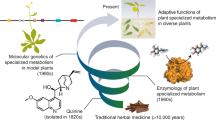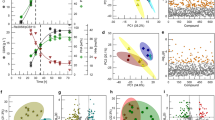Abstract
SOME plants contain organic compounds of potent physiological action on the animal organism; but as far as is known no biological function in the plants themselves. Are they waste end-products of metabolism ? Are they the result of detoxification mechanisms ? Are they produced to discourage attack by insects and animals ? Or are they mere ‘accidents’ or by-products of faulty metabolism—or perhaps even the results of evolutionary biochemical experiments not yet discarded ?
This is a preview of subscription content, access via your institution
Access options
Subscribe to this journal
Receive 51 print issues and online access
$199.00 per year
only $3.90 per issue
Buy this article
- Purchase on SpringerLink
- Instant access to full article PDF
Prices may be subject to local taxes which are calculated during checkout
Similar content being viewed by others
References
Wilson, A. T., Nature, 191, 714 (1961).
Wilson, A. T., and Gumbley, J. M., Nature, 197, 711 (1963).
Wilson, A. T., Gumbley, J. M., and Spedding, D. J., Nature, 198, 500 (1963).
Rafter, T. A., Tenth Pacific Sci. Conf., Hawaii, August, 1960, J. Geod. and Geophys. (in the press).
Broecker, W. S., Gerard, R., Ewing, M., and Heezen, B. C., J. Geophys. Res., 65, 2903 (1960).
Author information
Authors and Affiliations
Rights and permissions
About this article
Cite this article
SPEDDING, D., WILSON, A. Caffeine Metabolism. Nature 204, 73 (1964). https://doi.org/10.1038/204073a0
Issue date:
DOI: https://doi.org/10.1038/204073a0
This article is cited by
-
Biotechnological advances in tea (Camellia sinensis [L.] O. Kuntze): a review
Plant Cell Reports (2016)



